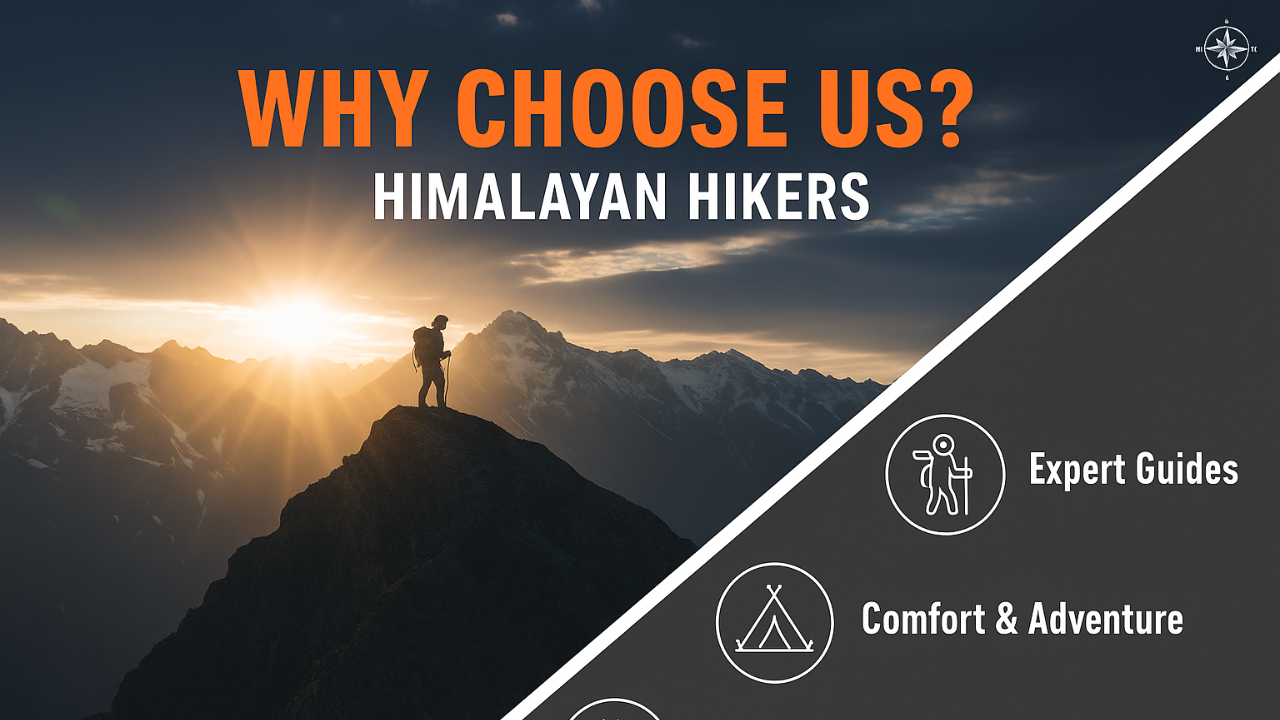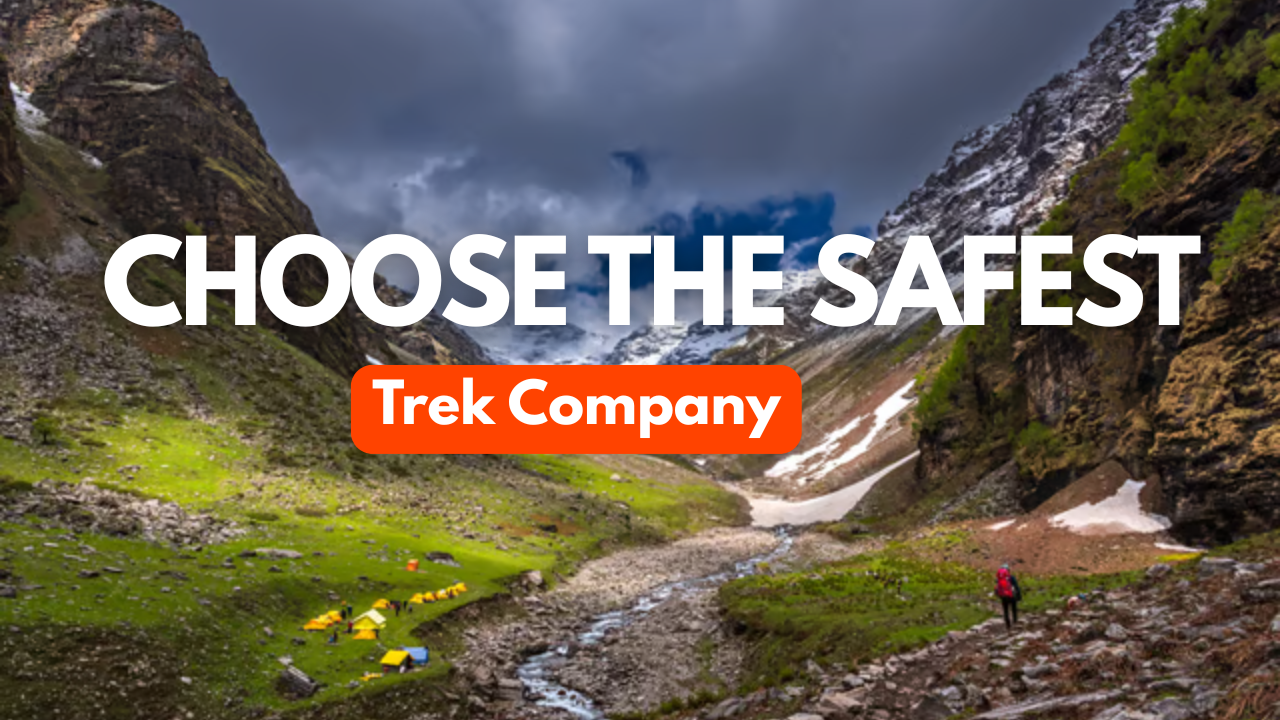Garhwal is a piece of heaven nestled in the Himalayas. Surrounded by the Bugyal or Velvet meadows and pristine snow-capped mountain, Chopta Tungnath and Chandrashila is considered a year-round holiday destination: Pleasant in summer, Experience, Monsoon rains – and a beautiful view of the changes. In winter, the snow-capped hills attract you to the fairyland. Chopta also comes in the center of Panch Kedar Trek route.
Deoriatal, Chopta, Sari Village, and Chandrashila Peak are all located in the Garhwal region of Uttarakhand, India, and are popular destinations for trekkers and nature lovers. Here are some highlights of each destination:
- Deoriatal: Deoriatal is a high-altitude lake located at an altitude of 2438 meters above sea level. The lake is surrounded by dense forests of oak, rhododendron, and deodar trees and offers stunning views of the Chaukhamba peaks. The trek to Deoriatal is a relatively easy one and is suitable for beginners.
- Chopta: Chopta is a small village located at an altitude of 2680 meters above sea level and serves as the base camp for several treks in the region. It is surrounded by forests of rhododendron, deodar, and pine trees and offers stunning views of the Himalayan peaks like Nanda Devi, Trishul, and Chaukhamba. The trek to Chopta is a relatively easy one and is suitable for beginners.
- Sari Village: Sari Village is a small village located at the base of the Deoriatal trek. It is a popular starting point for the trek and offers stunning views of the Himalayan peaks. The trek from Sari Village to Deoriatal is a relatively easy one and takes around 2-3 hours.
- Chandrashila Peak: Chandrashila Peak is a summit located at an altitude of 3965 meters above sea level and offers stunning views of the Himalayan peaks like Nanda Devi, Trishul, and Chaukhamba. The trek to Chandrashila Peak is a challenging one and involves steep ascents and descents. However, the stunning views from the summit make it all worth it.
What are some special things about Chopta?
Lord Tungnath also visits the five holiest Shiva temples in the state of Uttarakhand. On the left are the Lord shree Kedarnath and Madmaheshwar temples and on the right are the Sri Rudranath and Sri Kalpeshwar temples and just above it are the Sri Tungnath temples.
Although Chopta is also a bird’s paradise, many types of animals, birds are found here and you can see more than 200 above species of birds, including native and migratory species like Himalayan Monal, Himalayan Swiftlet, Himalayan Griffon, Scarlet Finch , Hill Partridge etc. Nearby places like Dugal bitta, Mandal village, Tungnath trek route are mostly sighted and Chopta has been declared as an important wild animal bird-watching site by National and International Conservation and Biodiversity Organizations. What makes this trek special?
About Tungnath Temple and Chandrashila Peak
Chopta, often referred to as the “Mini Switzerland of India,” is a serene and picturesque destination located in the Garhwal region of Uttarakhand, India. It is gaining popularity among nature lovers, trekkers, and adventure seekers. Here’s a detailed overview of what makes Chopta so special:
1. Natural Beauty:
- Lush Green Meadows: Chopta is famous for its undulating meadows (bugyals) that are carpeted with green grass in the summer and turn into a snow-covered wonderland in the winter.
- Dense Forests: It is surrounded by dense forests of pine, deodar, and rhododendron, making it a part of the Kedarnath Wildlife Sanctuary. The rhododendrons bloom beautifully in spring, coloring the landscape in bright red hues.
- Himalayan Views: Chopta offers panoramic views of the majestic Himalayan peaks, including Nanda Devi, Chaukhamba, Trishul, and Kedarnath, providing a stunning backdrop for trekkers and photographers.
2. Tungnath Temple:
- Spiritual Significance: Tungnath, the highest Shiva temple in the world, is located near Chopta at an altitude of 3,680 meters (12,073 feet). It is one of the Panch Kedar temples, and holds immense religious importance in Hindu mythology. The legend says that Lord Shiva’s arms appeared at Tungnath when the Pandavas sought his blessings to absolve their sins.
- Ancient Architecture: The temple is over 1,000 years old and is known for its stunning stone architecture, blending beautifully with the natural surroundings.
3. Chandrashila Peak:
- Stunning Panoramic Views: Chandrashila, literally meaning “Moon Rock,” is the summit of the Tungnath trek and stands at 4,000 meters (13,123 feet). The peak offers a 360-degree view of some of the tallest Himalayan ranges, making it an iconic spot for sunrise and sunset views.
- Mythological Connection: According to mythology, Chandrashila is the place where Lord Rama meditated after defeating Ravana, and it is believed to be the spot where the moon (Chandra) spent time in penance.
4. Ideal for Trekkers:
- Trek Accessibility: The Chopta-Tungnath-Chandrashila trek is one of the most accessible Himalayan treks. It is suitable for beginners due to its relatively moderate difficulty, and its short duration of 3 to 4 days makes it an excellent weekend getaway.
- Deoria Tal: This high-altitude lake, located near Chopta, is a famous trekking destination. Surrounded by forests, it reflects the Chaukhamba peak on clear days, offering breathtaking views. It is also popular for camping and stargazing.
5. Biodiversity:
- Kedarnath Wildlife Sanctuary: Chopta lies within the Kedarnath Wildlife Sanctuary, which is home to rich flora and fauna. The sanctuary protects species like the Himalayan musk deer, leopard, barking deer, and the red fox.
- Bird Watching: Chopta is a paradise for bird lovers. It is one of the best places to spot the Himalayan Monal, the state bird of Uttarakhand, along with other species like Eurasian jays, woodpeckers, partridges, and black eagles.
6. Weather and Climate:
- Mild Summers: During summer (April to June), Chopta experiences mild and pleasant weather with clear skies, making it ideal for trekking and exploring.
- Snowy Winters: From December to March, Chopta transforms into a winter wonderland with heavy snowfall. This makes it a popular destination for snow trekking and snowfall experiences. However, access to some areas may be restricted due to heavy snow.
7. Offbeat and Less Commercialized:
- Untouched by Mass Tourism: One of Chopta’s main attractions is its serenity and lack of commercialization. It is relatively lesser-known compared to other trekking destinations in the Himalayas, preserving its natural beauty and tranquility.
- Camping Experience: Due to limited hotel options, many travelers opt for camping, adding to the adventure. Waking up to the sound of birds chirping amidst the mountains and breathing in the crisp Himalayan air is an unforgettable experience.
8. Adventure Activities:
- Trekking: Chopta is the starting point for various treks, including the Tungnath-Chandrashila trek and the Deoria Tal trek.
- Snow Trekking and Skiing: During winters, Chopta becomes a hub for snow trekking and basic skiing activities.
- Photography and Stargazing: Chopta offers incredible opportunities for photography, especially for nature and landscape photographers. The clear night skies also make it an ideal place for stargazing and astrophotography.
9. Proximity to Other Attractions:
- Ukhimath: Just 31 km from Chopta, Ukhimath is a town of religious significance where the idols from Kedarnath and Madhyamaheshwar are brought during the winter months.
- Rudraprayag: Located about 65 km away, Rudraprayag is famous for its confluence of the rivers Alaknanda and Mandakini, and serves as a gateway to both Kedarnath and Badrinath pilgrimages.
10. Cultural Significance:
- The region surrounding Chopta is rich in Garhwali culture. Travelers can experience local hospitality, food, and traditions by interacting with the people of nearby villages, who often provide homestays and camping facilities.
Chopta Chandrashila Trek Guide
Day 1: Pickup from Rishikesh – Drive to Chopta Camp
- Pickup Time: 7:30 AM from Rishikesh Tapovan
- Distance: Approx. 212 km
- Total Travel Time: 8–9 hours
- Altitude: 2,012 meters
- Accommodation: Overnight stay at a hotel/camp in Chopta
Route- Overview:
Himalayan Hikers Transport picked up from Dehradun/ Rishikesh in the morning and begin your scenic drive towards Chopta, often referred to as the 'Mini Switzerland' of India. The journey takes you through the picturesque landscapes of the Garhwal Himalayas, with lush forests, winding mountain roads, and views of rivers and valleys.
Expect a few short breaks for Breakfast, and Lunch on the way. On arrival in Chopta by evening, check into your hotel or campsite. Enjoy a warm dinner and relax under the starry Himalayan sky to prepare for the next day's adventure. With Team Himalayan Hikers
Day 2: Trek from Chopta - Tungnath & Chandrashila Summit –then return to Chopta Camp
Early Morning: Start trek from Chopta Camp
- Trek Route: Chopta → Tungnath → Chandrashila Summit → Return to Chopta
- Trek Distance: Approx. 8 km (round trip)
- Trek Duration: 6–7 hours
- Maximum Altitude: 3,683 meters / 12,083 feet
- Accommodation: Overnight stay in camp at Chopta Himalayan Hikers
Route- Overview:
Begin your day early morning with a challenging yet rewarding trek to Tungnath, the highest Shiva temple in the world, and further ascend to Chandrashila Peak Summit, which offers breathtaking 360° views of major Himalayan peaks like Nanda Devi, Trishul, Kedar Dome, and Chaukhamba.
After spending some time take Group Photo with team then soaking in the stunning vistas and capturing memories at the summit, descend back to Chopta via tungnath . have Hot-lunch, take rest at Camp ,
Day 3: Drive from Chopta to Sari Vilage then Trek to Deoriatal – Return to Rishikesh
- Early Morning: Start trek from Sari Village to Deoriatal
- Trek Distance: Approx. 6 km (round trip Both way
- Trek Duration: 3–4 hours
- Trek Type: Easy to moderate forest trail with scenic views
- Highlight: Deoriatal Lake (2,438 meters)
- Post-Trek Drive: Sari to Rishikesh – Approx. 220 km
- Travel Time: 8–9 hours
- Arrival in Rishikesh: Between 8:30 PM and 9:30 PM
Route Overview:
After an early breakfast, begin your trek from Sari Village to the enchanting Deoriatal Lake, known for its crystal-clear reflections of snow-capped peaks like Chaukhamba. This serene alpine lake is surrounded by rhododendron and oak forests, making it a photographer’s paradise and a peaceful place to soak in the beauty of the Himalayas.
After exploring and resting at Deoriatal, take Group Photo return to the road head at Sari. From there, begin your drive back from Sari Village Rishikesh, with expected arrival in the late evening.
Day 1- Pickup to you from Rishikesh railway station morning at 7:30 am – Drive to Chopta Camp – 202 Km (7/8 Hours (2,012 Meters) overnight stay camp
The route from Rishikesh to Chopta is a scenic one, taking you through the beautiful countryside of Uttarakhand. Here are some highlights of the journey:
- Rishikesh: Haridwar is a holy city located on the banks of the Ganges river. It is famous for its ghats, where devotees come to take a dip in the holy river and perform religious rituals. Haridwar is also home to several ancient temples and ashrams.
- Rishikesh: Rishikesh is a spiritual town located on the banks of the Ganges river. It is famous for its ashrams, yoga centers, and adventure sports like rafting and bungee jumping. Rishikesh is also home to several ancient temples and is considered the “Yoga Capital of the World.”
- Devprayag: Devprayag is a small town located at the confluence of the Alaknanda and Bhagirathi rivers. It is considered one of the holiest places in Uttarakhand and is home to several ancient temples.
- Rudraprayag: Rudraprayag is a town located at the confluence of the Alaknanda and Mandakini rivers. It is considered one of the Panch Prayag (five confluences) of the Ganges river and is home to several ancient temples.
- Sari Village: Sari Village is a small village located at the base of the Deoriatal trek. It is a popular starting point for the trek and offers stunning views of the Himalayan peaks. The trek from Sari Village to Deoriatal is a relatively easy one and takes around 2-3 hours.
Day 2 – Chopta to Tungnath Chandrashila Peak summit 4130 m back to Sari village
The trek from Chopta to Tungnath and Chandrashila Peak is popular and relatively easy in the Garhwal region of Uttarakhand, India. Here are some highlights of the trek:
- Distance: The trek from Chopta to Tungnath Temple is about 3.5 km and takes around 2-3 hours to complete. From Tungnath Temple, the trek to Chandrashila Peak is about 1.5 km and takes around 1 hour to complete.
- Stunning Views: The trek offers stunning views of the Himalayan peaks like Nanda Devi, Trishul, Kedar Peak, Bandarpunch, and Chaukhamba. The views from the summit of Chandrashila Peak are particularly breathtaking and make for great photo opportunities.
- Tungnath Temple: Tungnath Temple is the highest Shiva temple in the world and is a popular destination for pilgrims. The temple is located at an altitude of 3,680 meters above sea level and is surrounded by stunning Himalayan peaks.
- Chandrashila Peak: Chandrashila Peak is located at an altitude of 4,130 meters above sea level and offers stunning panoramic views of the Himalayan peaks. The summit of the peak is marked by a small temple dedicated to Lord Shiva.
- Trekking Infrastructure: The trek from Chopta to Tungnath and Chandrashila Peak is a well-established trekking route and offers several facilities like campsites, clean water sources, and toilets. This makes it a comfortable and enjoyable trekking experience for people of all ages and fitness levels.
Day 3 – Sari village to Deorital explore the valley and back to road head same day Drive from Sari to Rishikesh
Start your trek after having breakfast, the trail from Sari is well-defined, it is maintained and is made up of rocks when you go further you can see some houses and a temple on the way.
After some time the trail will get steep and when you go higher you can have a glance of Chandrashila Peak and Tungnath temple as the forest is cleared. As you go higher on the mountain you will see a Hawa Ghar made up by the forest department, so that people going higher can relax there and can enjoy the views from there so you can rest there for some time and relish the beauty of that place.
Now, the trail is covered by Rhododendrons and Maple trees, walk under the shade of trees, continue walking, you will get some valley views as you come nearer to your destination. Walk downhill and you will reach Deoria Tal, you can see the flowers blooming, birds chirping as there are a variety of Himalayan birds there. Alluring greenery will relax your mind.
Drive from to Rishikesh (220 km) (7/8 Hours) you will reach Rishikesh between 8:30 pm to 9:30 pm.
Chopta to Rishikesh usually takes around 7-8 hours by car. The route passes through scenic landscapes and offers several opportunities to stop and enjoy the views. Here are some of the highlights of the return journey:
- Ukhimath: Ukhimath is a small town located en route from Chopta to Rishikesh. The town is famous for its ancient temples and is an important pilgrimage center in the region. The town also offers stunning views of the surrounding Himalayan peaks.
- Rudraprayag: Rudraprayag is a small town located at the confluence of the Alaknanda and Mandakini rivers. The town is considered to be a holy place and is famous for its ancient temples and stunning natural beauty.
- Devprayag: Devprayag is a small town located at the confluence of the Bhagirathi and Alaknanda rivers. The town is considered to be the birthplace of the Ganges river and is an important pilgrimage center in the region.
- Views of the Ganges: The route from Chopta to Rishikesh passes along the banks of the Ganges river and offers several opportunities to stop and enjoy the views. The river is considered to be a sacred river in Hinduism and is an important part of the region’s culture and heritage.
The Chopta Tungnath & Chandrashila Trek is considered to be of easy to moderate difficulty, making it suitable for beginners as well as experienced trekkers. Here’s a detailed breakdown of the trek’s difficulty level and factors that contribute to it:
1. Trek Gradient:
- Chopta to Tungnath (3.5 km):
- This part of the trek has a well-defined, stone-paved path with a moderate ascent. While the trail is relatively steep in some sections, it is manageable for most trekkers, even those with limited trekking experience. The altitude gain is gradual, so it does not pose serious challenges in terms of acclimatization.
- Tungnath to Chandrashila (1.5 km):
- The trek from Tungnath Temple to Chandrashila Peak is short but steep. The ascent is more demanding, especially in the final stretch, as you gain altitude quickly. This section requires more stamina and effort, particularly because of the altitude and steepness. However, it is not technically difficult—no specialized equipment or technical skills are needed.
2. Altitude:
- Tungnath Temple is located at an altitude of 3,680 meters (12,073 feet), and Chandrashila Peak reaches 4,000 meters (13,123 feet). While this is high enough to cause altitude-related issues like mild headaches or breathlessness, most trekkers do not experience serious altitude sickness. Acclimatization is usually not a major concern as the altitude gain is gradual, but it’s always important to stay hydrated and pace yourself.
3. Duration:
- The trek from Chopta to Tungnath takes about 3-4 hours at a relaxed pace. An additional 1-2 hours are required to reach Chandrashila, making the round-trip trek about 6-7 hours in total.
- This is not an overly long trek, making it manageable even for first-time trekkers with average fitness.
4. Weather Conditions:
- Summer and Autumn: In the warmer months (April to June and September to November), the weather is generally pleasant, with clear skies and moderate temperatures. This makes the trek less challenging as there’s no snow, and the paths are accessible and easy to follow.
- Winter: During the winter months (December to March), the trek becomes significantly more difficult due to snow and ice. The trail can get slippery, and the steep ascent to Chandrashila may require more effort due to snow accumulation. Snow trekking in this season can be more challenging, but also more rewarding for those who enjoy winter landscapes.
5. Fitness Requirements:
- While the trek is relatively easy, basic physical fitness is still essential. A person with average stamina who is able to walk uphill for 4-6 hours with breaks should be able to complete the trek comfortably.
- The trek requires no prior high-altitude trekking experience, but having some experience with hikes or day treks will certainly help.
- Regular cardio exercises, like walking, running, or cycling, a few weeks before the trek will enhance endurance and stamina, making the trek more enjoyable.
6. Trail Condition:
- The trail is well-marked and clearly defined, with stone steps leading up to the Tungnath temple and a dirt path extending toward Chandrashila. There are no technical sections, and the trek is suitable even for children and elderly trekkers, provided they are in good health.
- No technical gear like ropes, harnesses, or crampons is required for most of the year, although trekking poles can be helpful, especially for the steep ascent and descent.
7. Altitude Sickness:
- At elevations above 3,000 meters, some people may experience mild altitude sickness symptoms, such as headaches or shortness of breath. However, the gradual ascent helps mitigate this risk. Drinking plenty of water, taking regular breaks, and avoiding overexertion are essential to avoid any serious symptoms.
- The fact that Chopta is already at an altitude of 2,680 meters (8,790 feet) means that your body will already have some acclimatization by the time you start the trek.
8. Trekking in Groups vs. Solo:
- Trekkers can easily do this trek solo due to the well-marked paths and its popularity. However, trekking with a guide or in groups is often recommended for safety and the additional insight they provide, especially for beginners or during the winter season when trails might be covered in snow.
9. Trek Amenities:
- Rest Stops and Shelters: There are small tea stalls and rest areas along the route from Chopta to Tungnath, allowing trekkers to rest and refuel. During peak seasons, these stalls offer hot beverages and snacks.
- Accommodation: Chopta has basic accommodation options such as camps, guesthouses, and eco-lodges, making it easy to start the trek well-rested.
Conclusion:
- In Summer and Autumn: The Chopta Tungnath Chandrashila trek is easy to moderate, making it suitable for beginners with decent fitness levels.
- In Winter: The trek can become moderately difficult due to snow and icy conditions, requiring more effort and caution.
Best time to visit the Chopta – Tungnath – Chandrashila trek
🌧️ Monsoon (July to mid-September) – Not Ideal but if you are interest so, please Visit Trek Route and Road all Safe for Chopta
- Weather: Frequent rain, slippery trails, cloud cover
- Temperature: 15°C to 18°C
- Advantage Pros: Very green and less crowded
🍁 Autumn (Mid-September to November) – Excellent for Clear Views
- Weather: Crisp and dry; post-monsoon freshness
- Temperature: 8°C to 15°C
- Trail Condition: Excellent - offers breathtaking 360° views of major Himalayan peaks like Nanda Devi, Trishul, Kedar Dome, and Chaukhamba
- Highlights: Crystal-clear views of Himalayan ranges and Ideal for photographers and serious trekkers
❄️ Winter (December to March) – Snow Trek Season
- Weather: Cold and snowy trek route
- Temperature: -5°C to -10°C
- Trail Condition: Snow-covered; can be little bit challenging
- Highlights: --Magical snow landscapes
- Tungnath Temple is closed but Go there take outside Photo with group , but Chandrashila summit is accessible (if weather permits)
- Best for adventure lovers and snow trekking
Quick Chopta- Tungnath temple – Chandrashila Peak Trek Summary:
|
Season |
Snow |
Views |
Trail Condition |
Recommended? |
|
April–May |
❄️ Moderate |
🌄 Excellent |
🚶♂️ Snowy/Mixed |
✅ Yes |
|
October–Nov |
🚫 None or minimal |
🌄 Crystal Clear |
🚶♂️ Dry & Safe |
✅ Yes |
|
Monsoon (Jun–Sep) |
🌧️ Rainy |
⛅ Poor |
🌿 Slippery |
❌ No |
|
Winter (Dec–Mar) |
❄️ Heavy Snow |
🌨️ Often Cloudy |
🧗 Moderate Difficult |
✅ Yes |
How to reach Haridwar or Rishikesh from different cities in India. Here are some of the common transportation options:
We reach Haridwar or Rishikesh, which are the common starting points for the Chopta Tungnath Chandrashila trek, you can use various transportation options. Here’s a guide to getting to these cities from different parts of India:
1. By Air:
- Nearest Airport:
- Jolly Grant Airport, Dehradun (about 35 km from Rishikesh and 55 km from Haridwar).
- From Major Indian Cities:
- Delhi to Dehradun: Multiple daily direct flights, approximately 1 hour.
- Mumbai to Dehradun: Direct flights (2-2.5 hours) or via Delhi.
- Bangalore to Dehradun: Direct flights (3 hours) or connecting flights via Delhi.
- Kolkata to Dehradun: Connecting flights via Delhi, approximately 4-5 hours.
- Chennai to Dehradun: Connecting flights via Delhi, around 4-6 hours.
- From Jolly Grant Airport:
- You can take a taxi or pre-arranged transport to Haridwar (45 minutes) or Rishikesh (30 minutes).
2. By Train:
- Haridwar Railway Station (Code: HW) and Rishikesh Railway Station (Code: RKSH) are the nearest railway stations, with Haridwar being the more prominent of the two.
- From Delhi:
- Shatabdi Express (5-6 hours) is a fast and comfortable option.
- Other trains like the Jan Shatabdi, Mussoorie Express, and Nanda Devi Express also ply regularly.
- From Mumbai:
- Dehradun Express (via Haridwar, 24-26 hours).
- From Kolkata:
- Doon Express (approximately 30-32 hours).
- From Chennai:
- Dehradun Express or Madurai Dehradun Express (34-36 hours) via Haridwar.
- From Bangalore:
- Yeshvantpur Haridwar Express (44-45 hours).
- From Jaipur:
- Haridwar Mail and other direct trains (11-13 hours).
- From Lucknow/Varanasi:
- There are several trains to Haridwar with travel times of 8-14 hours depending on the route.
3. By Road:
- From Delhi:
- Rishikesh and Haridwar are well connected by road and can be reached by bus (6-7 hours). Both government buses (Uttarakhand Transport Corporation) and private buses operate frequently.
- Taxis or self-drive options are also available, with the drive taking approximately 5-6 hours via NH 334.
- From Chandigarh:
- A direct drive takes about 5-6 hours (approximately 200-230 km) via NH 7.
- From Jaipur:
- Road distance is about 500 km, taking roughly 9-10 hours by bus or taxi. Buses to Haridwar/Rishikesh run regularly.
- From Other Cities:
- Several luxury buses and Volvo services connect Haridwar/Rishikesh with other major cities like Lucknow, Kanpur, Agra, etc.
How to Reach Chopta from Haridwar/Rishikesh:
Once you reach Haridwar or Rishikesh, you need to travel by road to Chopta, the base for the Tungnath-Chandrashila trek.
- Distance from Haridwar to Chopta: 200 km (approx. 7-8 hours by road)
- Distance from Rishikesh to Chopta: 160 km (approx. 6-7 hours by road)
1. By Taxi or Private Vehicle:
- Hiring a taxi is the most convenient way to reach Chopta from Haridwar or Rishikesh. Taxis can be booked from Rishikesh/Haridwar to Chopta.
- The route passes through Devprayag, Srinagar, and Rudraprayag, offering beautiful scenic views along the way.
2. By Bus:
- Buses from Haridwar/Rishikesh to Rudraprayag or Ukhimath are available. From Rudraprayag/Ukhimath, you can hire a taxi or shared jeep to reach Chopta.
- Direct bus services to Chopta are limited, so you’ll often need to break the journey and switch to local transport at Rudraprayag or Ukhimath.
3. Self-Drive:
- You can also drive yourself from Haridwar/Rishikesh to Chopta if you prefer. The roads are mostly in good condition, except for a few rough patches near Chopta. However, during winters, snowfall can make the roads slippery, so driving should be done with caution.
Suggested Route from Haridwar/Rishikesh to Chopta:
- Haridwar/Rishikesh → Devprayag → Srinagar → Rudraprayag → Ukhimath → Chopta
- This is the most common route, offering smooth connectivity and scenic views throughout the journey.
Conclusion:
Reaching Haridwar or Rishikesh from different cities in India is convenient through flights, trains, and buses. Once you arrive, road transport options like taxis and buses can take you to Chopta, the base for the Tungnath Chandrashila Trek.
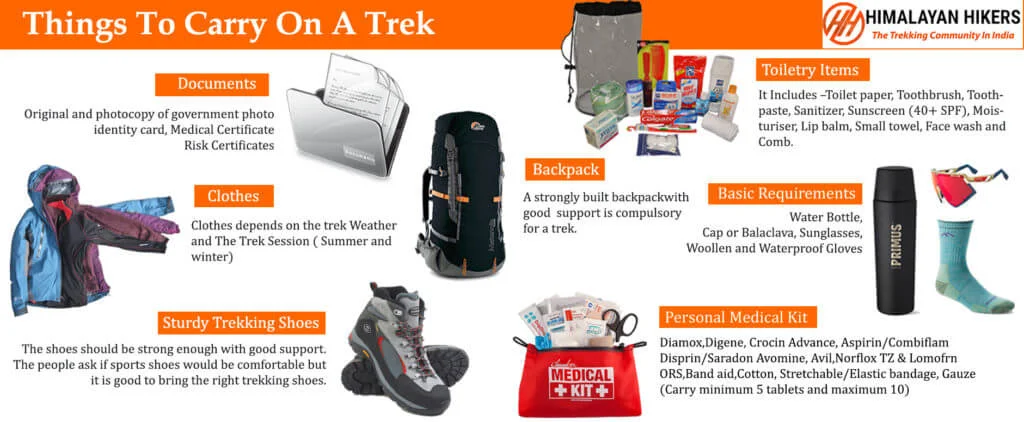
Mandatory Documents
Original and photocopy of government photo identity card- (Aadhar Card, Driving License, Voters ID, etc,)
Passport and Visa important to foreigners
Medical Certificate (First part should be filled by the Doctor and Second part by the Trekker)
Declaration Certificates
Note: – Many trekkers commit the same mistake of carrying unnecessary items on a trek which only makes the backpack heavy. It is important to know the right items to carry. It differs from season to season if you are trekking in summers then carry less layers of warm clothing and if you are trekking in winters carry enough layers to protect yourself against chilly cold.
Necessary Items for trekkers
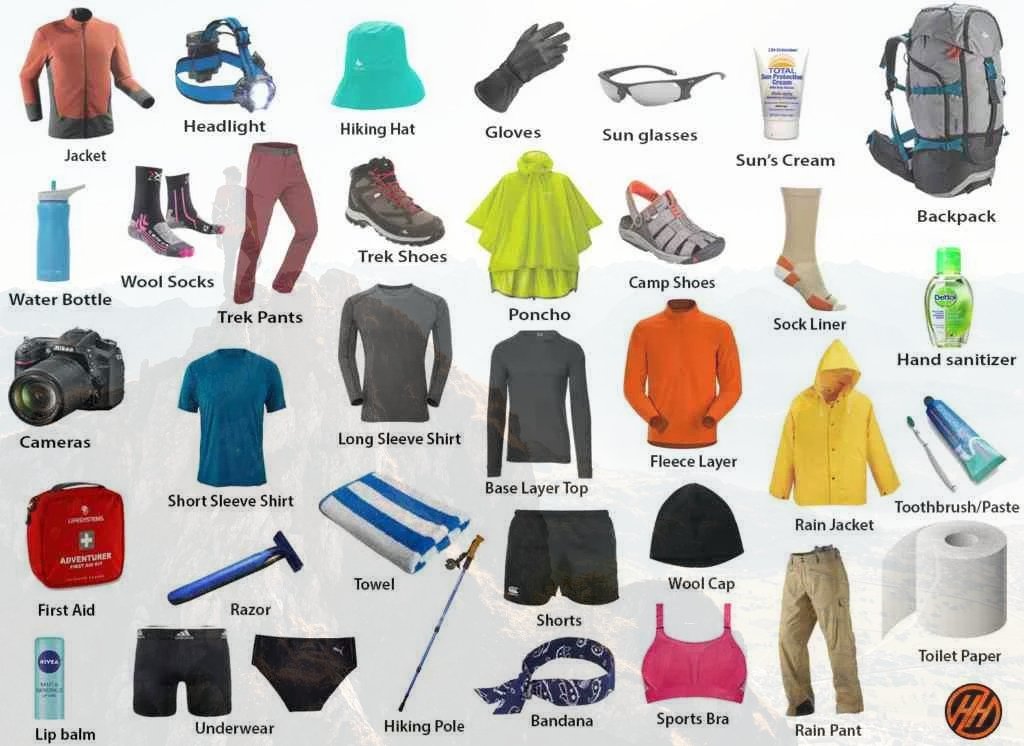
Basic Trekking Gears

The Clothes You Should Bring On Satopanth Expedition
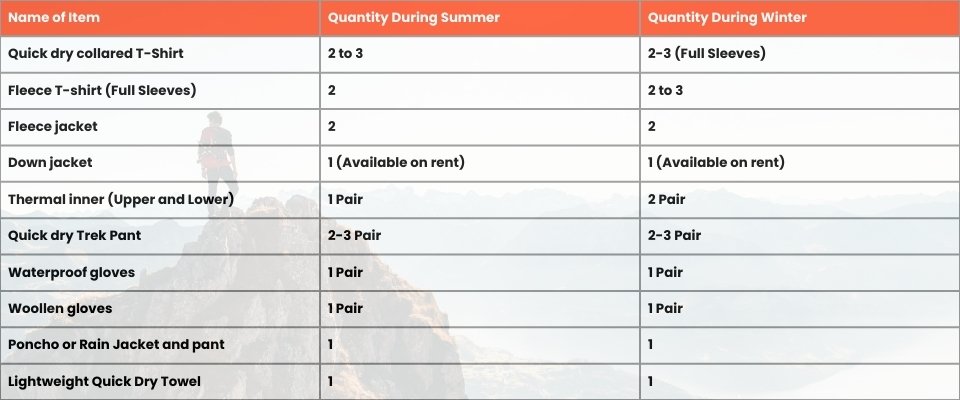
Head Gears

Foot Gears

Personal Care Essentials

Carry a Personal Medical Kit
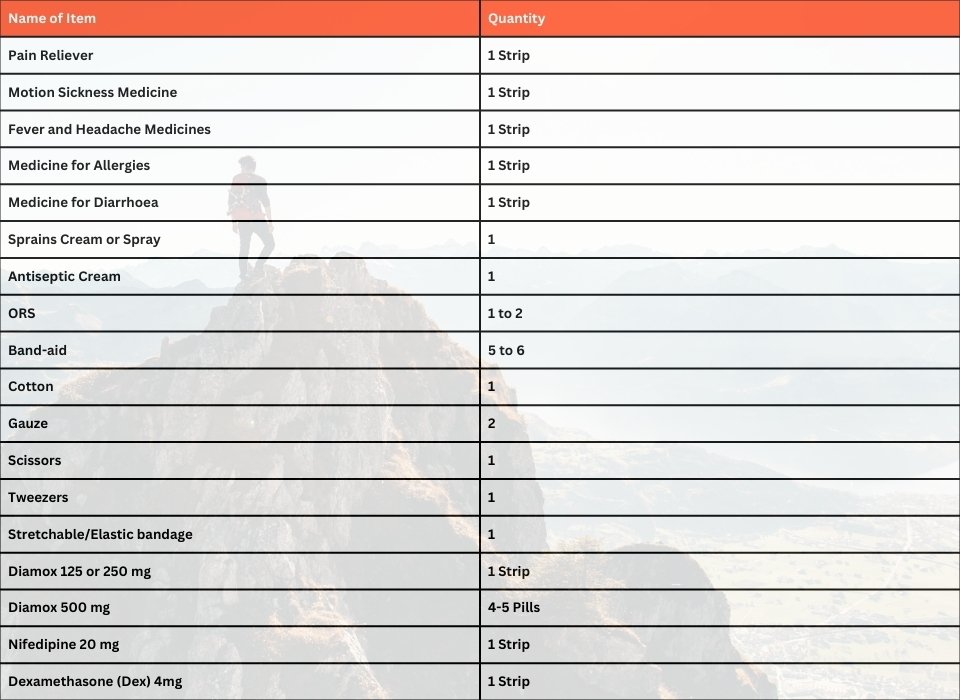
Are you Looking for Trekking Equipment on Rent?
If any trekker requires trekking equipment on rent, Himalayan Hikers offers the best-quality gear available for rental. Many individuals are in need of such equipment, and renting provides a cost-effective solution, allowing them to access high-quality gear at an affordable price without the need for a significant investment for short-term use.

Trek Equipment You can book directly on first day at the Base Camp.
Note:-
Please take all medicines only when prescribed by the doctor. In case you face any problem during your trek,
discuss and take advice from the Professional guide.
The Trek is one of the most popular treks in Uttarakhand, Himachal,Kashmir,Laddakh,Sikkim,Nepal, requiring both physical preparation and mental readiness. Although it is categorized as a moderate trek, reaches an elevation of over 12,720 feet and traverses remote Himalayan terrain, which can be physically and mentally challenging. Here's how you can prepare yourself for a safe and successful accomplishment of the Trek:
Physical Fitness
Building a good fitness base is essential for every trekker. The Trek itinerary involves 5 to 6 hours of walking every day. Though the trails are well-marked, they are often bumpy and include steep uphill sections, which may affect your stamina. You can overcome your physical limitation with a 6-week training program that you can begin about 2 months before your Trek. Your 6-week fitness routine should include

Pro Tip: If you have time, you can skip the Sunday training and go for a long-distance walk or mini day-hike (7–10 km) with a loaded backpack to simulate real trekking conditions. A short 1-day hike around your city/town can help a lot.
Mental Preparation
Physical strength is only half the journey, the other half is mental resilience. The trail takes you through remote clearings, steep climbs, cold starry nights, and no mobile connectivity. Be prepared to:
(I) -
Detach from the digital world.
(II) -
Embrace basic mountain living (camping, toilet tents, limited electricity).
(III) -
Push through moments of fatigue, weather discomfort, or altitude effects.
Himalayan Hikers is a reputable trekking company that places a high priority on safety. Here are some of the safety measures they take to ensure the safety of their clients during the Trek:
Experienced Guides: Himalayan Hikers hires experienced and certified guides who are well-versed in the terrain, weather conditions, and local culture. These guides have first-hand knowledge of the routes and are equipped to handle any emergency situations that may arise.
Proper Gear: The company provides all the necessary gear and equipment to their clients to ensure comfort and safety during the trek.
Hygiene and Sanitation: Himalayan Hikers places great emphasis on hygiene and sanitation during the Trek. They provide clean drinking water, hand sanitizers, and toilet tents to ensure that their clients are healthy and comfortable.
Emergency Services: The company has a well-defined protocol for handling emergency situations. They have a team of trained medical professionals who are available 24/7 and can be quickly mobilized in case of an emergency.
Acclimatization: Himalayan Hikers follows a gradual acclimatization process during treks to ensure that their clients adjust to the high altitude gradually. They also monitor the health of their clients regularly and provide necessary medical attention if required.
Overall, Himalayan Hikers places a great emphasis on safety and takes all necessary measures to ensure the safety and well-being of their clients during treks.
Trek Inclusions
What is Included In This Trek?
Transport from Rishikesh to Rishikesh or Dehradun – Tempo Travellers
Forest Permit and entrance fee
Accommodation in Swiss tents on twin/three share basis
All meals: Breakfast, lunch, Tea, Coffee, Snacks, Dinner
Separate Toilet tents – Ladies and Gents
Dining Tent
Dining Table
Kitchen team
Radio Walkie Talkie for Communication
Good Experience Trek Leader guide and Technical guide
Medical Kit
Oxygen Cylinders
Crampons and Gaiters
Trek Exclusions
What is Not Include In This Trek?
Personal Insurance
Medical Certificate
Personal toiletry Items and Personal Medicine kit
On first day En Route to base camp the Breakfast and Lunch are Not Included
Last Day En Route Lunch and Dinner are Not Included
Personal used Porters
Important Note
Himalayan Hikers offers both online and offline booking options for their treks. Here’s a breakdown of both options:
1. Online Booking:
- Website: Himalayan Hikers has an official website where trekkers can browse through different treks, check details (itineraries, costs, difficulty level, etc.), and make bookings. Payment gateways are integrated for secure online transactions.
- Third-Party Platforms: They might also be listed on various trekking or adventure booking platforms, where you can compare prices, read reviews, and make bookings.
- Email Communication: Trekkers can inquire about treks via email and complete the booking process online, following email communication and payment.
2. Offline Booking:
- Direct Office Visit: Himalayan Hikers has physical offices (especially in Uttarakhand), where trekkers can visit in person, discuss treks, and complete bookings directly.
- Phone Booking: You can also call their office to make a booking. Details about payment methods, trek dates, and other logistics can be confirmed over the phone.
Yes, Himalayan Hikers requires a 25% advance payment for booking treks, Via- Google pay or UPI, Directly Himalayan Hikers Account with the remaining amount to be paid in cash at their branch office in Sankri before the trek starts. This payment structure is typical for ensuring that bookings are confirmed while allowing trekkers flexibility in completing the payment when they arrive.












